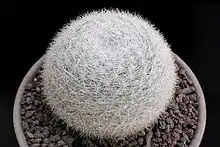Mammilloydia
Mammilloydia is a genus of cactus containing the sole species Mammilloydia candida, the snowball cactus.[1]
| Snowball cactus | |
|---|---|
 | |
| Scientific classification | |
| Kingdom: | Plantae |
| Clade: | Tracheophytes |
| Clade: | Angiosperms |
| Clade: | Eudicots |
| Order: | Caryophyllales |
| Family: | Cactaceae |
| Subfamily: | Cactoideae |
| Genus: | Mammilloydia |
| Species: | M. candida |
| Binomial name | |
| Mammilloydia candida | |
| Synonyms | |
|
Chilita candida (Scheidw.) Orcutt | |
Description
Mammilloydia candida is green, globe-shaped, but with age it becomes almost cylindrical. It can reach a diameter of about 15 centimetres (5.9 in) and a height of about 30 centimetres (12 in). As is usual in the genus Mammillaria, this plant has no ribs. The flowers are pink or white. The plant is covered by fine white hair. The spines are short, very numerous, usually snow white or brown.
Distribution
This species originates from Mexico (Coahuila, Nuevo León, San Luis Potosí and Tamaulipas).
Habitat
The natural habitat of Mammilloydia candida is the desert. It grows in the thickets of xerophytic shrubs on calcareous soils, at an altitude of 500–2,500 metres (1,600–8,200 ft) above sea level.
References
- Anderson, Edward F. (2001), The Cactus Family, Pentland, Oregon: Timber Press, ISBN 978-0-88192-498-5, p. 450